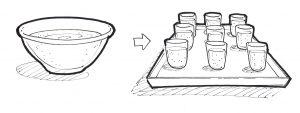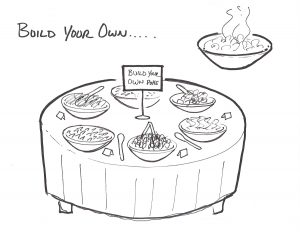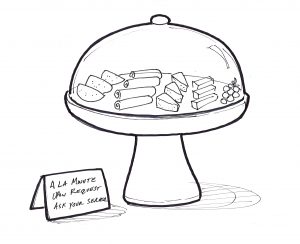Prevent Waste in Serving
Preventing food waste in the serving phase
Buffets are the largest culprit contributing to food waste in hotels. This waste can be prevented during the serving phase by strategically setting the buffet, thoughtfully messaging to guests and maximizing donation of unavoidable overproduction. The major roles and activities involved in this phase include:
![]()
![]()
![]()
Setting the Buffet | During Service | After Service
Setting the Buffet
- Check headcount before setting buffets or plated meals.
- Display foods horizontally instead of piling for items like breads and pastries
 Serve items in small, individual serving vessels instead of chafing dishes.
Serve items in small, individual serving vessels instead of chafing dishes.- Separate mixed items when possible to give guests choice while maintaining freshness.
- Use dispensers, jars and dishes with lids to preserve food quality for reuse.
 Reduce plate size and shrink serving utensils. Offer small utensils for sample servings at the buffet.
Reduce plate size and shrink serving utensils. Offer small utensils for sample servings at the buffet.- Use temperature controlled vessels to preserve food quality.
- Set certain high value items as a la carte.
- Place conscious consumption cues on the buffet to engage guests in waste reduction efforts.
- Use service stations at the buffet to control portion size and maintain food quality.
During Service
 Put out increasingly smaller chafing dishes and top off or back fill when necessary.
Put out increasingly smaller chafing dishes and top off or back fill when necessary.- Facilitate communication between banquet and culinary staff to relay buffet supply status and enable a la minute replenishment.
- Use real time updates between banquet staff and culinary staff to communicate food supply status of buffets to optimize replenishment.
After Service
- Dedicate food waste bins to banquet breakdown stations.
- Track the waste and enable feedback to culinary on which items went unused, overset or wasted on guest plates. Inform future procurement and meal prep with this data.
- Use blast chilling equipment to preserve food quality for reuse or recovery.